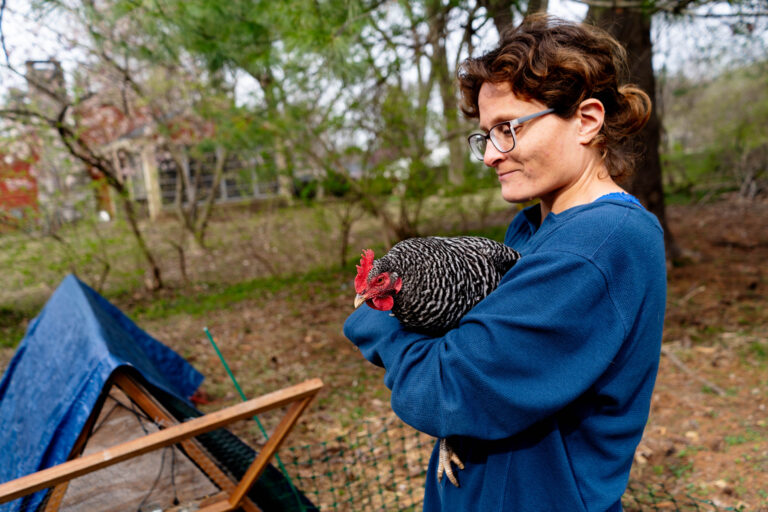In fall 2020, Leah Shaffer ordered four chickens from a Missouri hatchery — a pandemic impulse purchase to get her two children outside, she said.
“I wanted them to have a reason to go out basically into the backyard and just have some real life sort of experience with nature instead of just computer time,” said Shaffer, who lives in St. Charles, Missouri.
Listen to this story here.
The four hens — Gertie, Jeff, Cherry and Rivers Cuomo — have been very healthy. They’re energetic. And they’re laying eggs.
But a highly pathogenic avian flu is sweeping across the country, reaching commercial poultry operations and backyard flocks from Maine to Iowa, down to Missouri and across to Wyoming. More than 22 million chickens, turkeys and backyard birds have died from the illness or had to be destroyed. The highly contagious viral disease, commonly known as bird flu, can be deadly to birds, including chickens.
For Shaffer, predators are a bigger concern for her small flock, which she keeps an eye on from her kitchen window.
“I’m pretty confident that they’re safe,” she said. “… I notice right away that they’re sick — if anything changes, I’ll see them right away and I’ll get them over to a farm vet.”
Yet Shaffer said she’ll think twice about adding more chickens to her flock as the virus spreads.
Much of the attention of the 2022 bird flu outbreak has been on commercial poultry that make up the bulk of the cases. Larger commercial operations can house millions of chickens, all of which would need to be killed to keep bird flu from spreading if the virus reached one of these larger flocks.
The poultry industry asserts that it has learned a lot since the December 2014-June 2015 highly pathogenic avian influenza outbreak, when more than 50 million chickens and turkeys died from illness or were killed to stop the spread.
One of those lessons has been biosecurity. Producers have beefed up the precautions they take to keep germs and diseases out of their barns.
Turkey grower Ben Slinger is limiting visitors on his farms near Ellsworth, Iowa, to prevent bird flu from reaching his flocks.
“It is a very concerning time,” Slinger said. “We’re watching stuff extremely closely.”
Slinger raises about 850,000 turkeys a year for an Iowa meat processor. In May 2015, bird flu hit his family hard. He had to cull 38,000 turkeys to stop the disease from spreading. The family sat without turkeys for months.
So Slinger and his workers now wear dedicated boots into each barn to avoid tracking anything in. They also walk through disinfectant before entering the barns. After bird flu reached a nearby commercial turkey flock, Slinger is testing turkeys for the virus more frequently.
“We’ve been in pretty good shape,” he said. “This year is definitely going to challenge us, it seems like, in the coming weeks as to if we're truly prepared again for what happened in 2015.”
State officials and scientists also caution backyard flock owners to be on high alert. Bird flu has reached these small flocks in Missouri, Illinois, Iowa, Kansas and Nebraska.
“The backyard or small flock producers, they're not as aware of this,” said Don Reynolds, a professor and poultry veterinarian with the University of Nebraska–Lincoln. “So they are more susceptible.”
Reynolds said some backyard bird owners may not be around their birds as much as commercial producers looking for symptoms. Chickens can show signs like a lack of energy and appetite, a decrease in egg production and diarrhea. They also may cough, sneeze or have runny beaks, yet birds can suddenly die without showing any clinical signs of the disease.
Backyard flock owners need to be especially alert about wild birds passing through on their migration and mingling with their chickens, Reynolds said.
“They’re housed outside, they can have exposure to these wild birds,” he said. “These wild birds can transmit the avian influenza. That’s very, very concerning.”
Wild birds can shed the virus through their saliva or droppings. Reynolds said wild birds could even spread it through drinking the same water or eating from bird feeders.

Kristin Dennis of St. Louis stopped filling her bird feeders for that reason.
Dennis has had chickens since 2010 and added ducks to her flock during the pandemic. She has been closely monitoring her 16 chickens and ducks for bird flu symptoms and is keeping them in their enclosure.
“Because from what I can tell it kills the birds very, very quickly and it's very, very contagious,” she said, “and I would just be heartbroken if they got sick.”
All of her birds have names and personalities, said Dennis, and she can’t imagine losing any of them. After the last big bird flu outbreak she learned that backyard flocks made up 10% of all birds that died or had to be destroyed.
“To me that suggests it really devastated a lot of peoples’ home flocks,” Dennis said, “which really makes me think twice and maybe three times about making sure to put precautions in place to keep mine safe.”
Follow Katie on Twitter: @katiepeikes
Harvest Public Media reports on food systems, agriculture and rural issues through a collaborative network of NPR stations throughout the Midwest and Plains.

